 |
 |
 |
 |
 |
 |
 |
 |
| | NEWS | | ARCHIVES | | ECO-LOGICAL | |
We will publish monthly travel topics in this section regarding specific equipment, health, surf forecasting , transport, travel operators...Stay in touch subscribing to our free mailing list.
THE FISH EATING DESERT
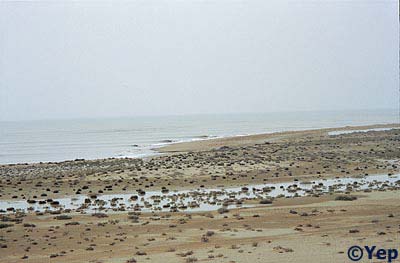
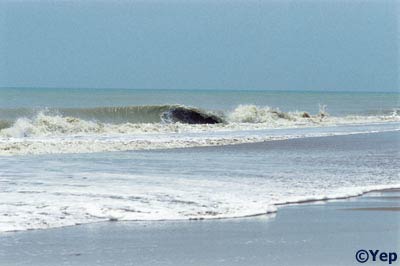 |
The Navy's Chief of Intelligence silently closed the surf magazine that he'd
been flipping through, stood up and walked over to a shelf stacked with rolled
up maps and military charts, running his eyes over them he pulled out the map
he was looking for and returned to his desk. Unfolding it he said, "I think
you'll find what you're looking for here" and jabbed his finger down at the
map. The desert of the fish eaters stretches from the borders of Iran eastward across Baluchistan, the birth place of the Taliban, and on towards Karachi, Pakistan's largest and most strife torn city. More than 2000 years ago Alexander the Great led his armies across these desert sands after successfully conquering half the known world, his journey has been portrayed as his last heroic battle, one against nature herself and never did he come closer to disaster than out herein the Makran desert. After him no other foreigners are known to have entered the Makran until 1809, it's as if the story of Alexander the demi-god having come so close to death, had scared away all other mere mortals from attempting to tame the desert. ). |
| Our own journey there had a sense of unreality to it, the idea was born in a sunny Biarritz office as Guéthary stand-up surfer, Antony Colas and myself, studied the weather maps and swell charts for the Arabian Sea whilst working on the Stormrider World Guide. The potential was there, between June and August it seemed as if swells generated off the coast of Somalia crashed into the Pakistani coastline on a near daily basis, but research showed that if ever there was an impossible surf trip then this was it. The Pakistani embassy near enough laughed in our faces when we said we wanted to go surfing in the Makran desert, not just had no surfers ever been there before, but foreigner visitors of any type can be counted on ten fingers. If we were to be allowed to the Makran then there were some daunting problems to overcome, coastal temperatures of 45 degrees day in and day out, numerous sharks, no tourist infrastructure, no roads or transport, except camels and the very real chance of bumping into smugglers bringing drugs and guns out of Afghanistan. It's also a politically sensitive area thanks to several strategic Naval bases along the coast and its use as the test site for Pakistan's nuclear arsenal. In the 2000 odd years since Alexander's visit the Makran seemed to have given up little to the modern world and so it came as no surprise when the Pakistani embassy told us that it would be "impossible to visit". At this stage we should have given up and focused on other destinations, but we couldn't let go of it now, the challenge was too much to resist, this was our chance to do some real life exploring and go to places seen by no other foreigner. Slowly a team of like-minded and equally optimistic people built up, Ben Clift, a dropkneer from west Cornwall was first to sign up, quickly followed by Dan Haylock, a Bude stand-up. Magazine and film companies gave us advice and support, whilst equipment and finances came from C-Skins wetsuits, Saltrock clothing, Rheopaipo boards and Pakistan International Airlines, but despite all these people placing there faith in us the Pakistani government still refused to give us the necessary permission. Our lucky break came after the Pakistani tourist board put us in touch with a guy they thought might be able to help. Haroon Pirzada turned out to be worth his weight in gold, without his determination, knowledge and numerous contacts our journey would have remained nothing but a wild dream. He spent weeks visiting government officials and military representatives putting forward our case and pleading for visas and permits. Then one morning came a phone call from the Pakistani embassy in Paris, "We have received authorisation from Islamabad allowing you to travel to the Makran desert". | 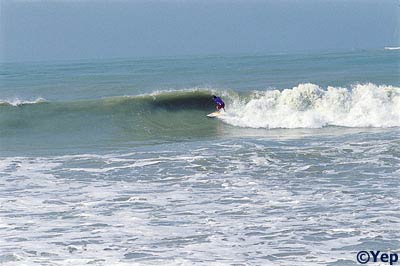
|
| One month later we were sat in an office in the military town of Ormara, halfway along the coast of the Makran desert, the Navy's Chief of Intelligence looked up from the map and said, "Yes, this is where you'll find good waves". As it turned out we didn't find any decent waves where he recommended, but at the halfway point on the toughest journey any of us had ever been on we had already had the satisfaction of finding constant swell and quality waves in one of the planets wildest and remotest places. The government had imposed restrictions and conditions on our visit, we were always to be accompanied by armed guards and we had to visit the district commissioners and military officials of each region that we passed through in order to seek permission to stay in their area. Some welcomed us, some sent us away, worried about the consequences if something happened to us whilst under the protection. We'd started our journey far to the west, in Gwadar and journeyed to within a stones throw of the Iranian border where we'd discovered a long right point break that wound down the side of a cliff, small but walled up and fun. Closer to Gwadar was a long, overhead right that broke on sandbars a twenty minute paddle out to sea, when we surfed it the first time the entire population of the nearby village came out to watch, they'd been convinced that we were going to die and when we returned to the shore we were mobbed by several hundred people who pressed around us, trying to get a glimpse. The crush became so intense that our guards had to intervene and push the crowds back. |
|
| Along with our armed guards we also had drivers for our three 4WD jeeps, a cook and the guide, translation and co-ordinating services of Haroon and Shaukat. As well as these eight we frequently found ourselves with Naval or Coastguard escorts who'd lead us over sand dunes and along empty gullies to beaches and headlands that even they had never before visited. Two years ago I traversed the Sahara in a search for waves, in comparison crossing the Makran made my Saharan journey seem like a walk in the park. The main problem was the heat, it was of an intensity that I've never before experienced, draining us all of energy and putting everyone on edge. Moving around was also a major problem, roads are unknown out here and camels the most convenient and popular form of transport, sometimes we'd have literally to dig and push our jeeps through clouds of dust to the beach. Afternoons would see sandstorms rolling in blanketing everything in a thick layer of fine sand and reducing visibility to the end of the jeeps bonnets. More than once we became lost in these storms and would have to stop and wait for them to clear, once the sand in the air was so thick that we actually became separated from each other and drove off across the desert plains in opposite directions. | 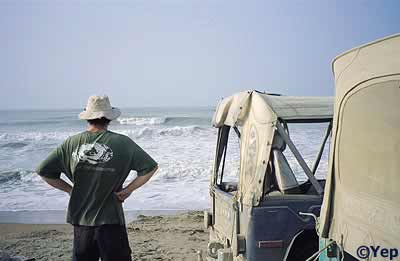 |
| Most days had an air of similarity to them and rarely were they completely enjoyable, even the Pakistanis were calling this one of the toughest expeditions they've been involved with. Hours were spent in the back of hot and uncomfortable land Rovers followed by intense, heavy sessions in hollow shore breaks or small and dreamy points and at night we'd camp out under a luminous desert sky. As I try and recall certain days one in particular stands out, we were searching for waves near the small centre of Pasni when we stumbled straight into the middle of a stand-off between a platoon of Coastguards and an estimated 200 smugglers bringing heroin out of Afghanistan on the back of camels. Offshore we could see boats waiting to whisk the priceless cargo onwards to the waiting world. For most of the previous night the gunfire had raged and one of the Coastguards had been shot, though in the heat of the day all seemed calm and both sides rested and planned there next move. In normal circumstances we would have turned and fled, but just down the beach we could see a sand spit right point that was mesmerising in its perfection. We were looking at it side on and from this angle it appeared that we had surpassed Kirra, wide open pits peeled at a breakneck pace down the point, we were maybe a kilometre away yet could see clearly into the almond shaped barrels. The Coastguard advised us against it, as did our guards and drivers, but like men possessed we were onto it. When we got closer to the wave we discovered that it was actually much smaller than it had looked and breaking onto almost dry sand, but never the less what followed can only be described as a barrel fest. Around us smugglers and gunmen were hiding out in the hills and the Coastguards braced themselves for another onslaught. As a flawless wave approached me I couldn't help but think about this strange meeting between two alien worlds and I wondered if they realised that the thing that had brought us to the desert of the fish eaters was far more addictive than any drug they could send out to the desperate west. I turned and dropped into a tube in the land that even Alexander the Great had failed to conquer. Stuart BUTLER |
|
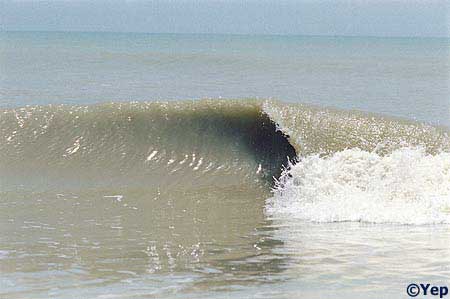
Further infos :
www.geographical.co.uk/expeditions_travel/expeditions/pakistan_expedition.html
www.surfmagic.co.uk/news/article.asp?SP=&v=&UAN=782
www.sandskater.co.uk/travel/pakistan.html
THE PAKISTADORES OF THE MAKRAN COAST. Part II
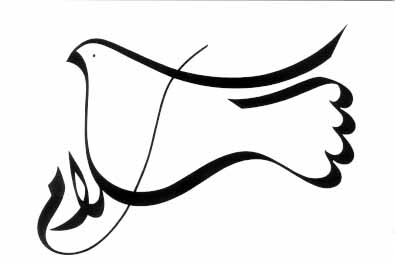
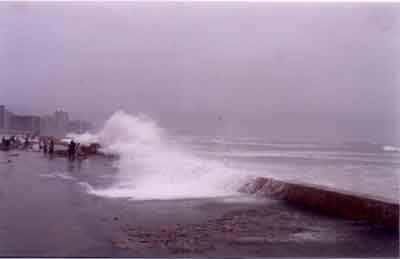 |
In a couple of days, we're off to the Makran Coast in Pakistan, looking for one the most landlocked surfspots in the world. We've been postponing the trip by a week because of slow visas, land authorization delays and different problems. Unfortunately, our photographer Lolopipe suffered from a sudden virus-infected desease and had to cancel his trip. So, we're 4 people (2 UK bodyboarders, 1 UK surfer and 1 french surfer) heading to Gwadar via Karachi. We decided to move eastwards as the W-SW swell direction will increase our chance to get surf while getting towards Karachi. Karachi itself should get some surf on the most exposed beaches like Clifton above. We spend one day in Karachi then 3 weeks cruising the coastline as close to the shore as possible with Trans-Pakistan services. We've decided to favor jeeps instead of camels due to the intense heat ( 38° to 45°). |
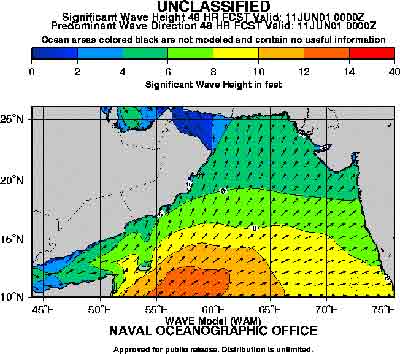
| The good news is that the SW monsoon has already started to blow actively and stirred up some huge seas off Somalia, creating heaps of wind driven swell hitting Socotra, Yemen, Oman and hopefully the final shores of Pakistan . That's why scientists call it the Somali Current, these are the highest tradewinds in the tropical zone worldwide. Swell at sea should be in the 6-10ft range, with 6-15sec period while wind patterns should be in the SW force 4, losing much power as it hits the desertic coastline. We're just waiting for an epic J-Bay like spot to come out of the blue and finally have our boards wet after 2 years of thoughts and 6 months of preparation. We brought a 7'3" Bic board to give away to a fishermen village kid. Obviously, it's gonna our most exciting surftrip ever balancing the joy of finding the absolute perfect wordclass and dealing with the inherent dangers of such a wild environment. Actually, we can't make out now if the land risks are higher than the sea hazards. LAND : Heat and dust, bumpy road breakdowns, snakes&insects, smugglers (we have an armed guard), lack of emergency procedures and hospital care. SEA : Sunstroke and sunburns (water is 29°c), Beaked Sea snakes, myriads of sharks ( hammerhead, tiger, blacktip, whitetip...). We'll see and keep you posted. |
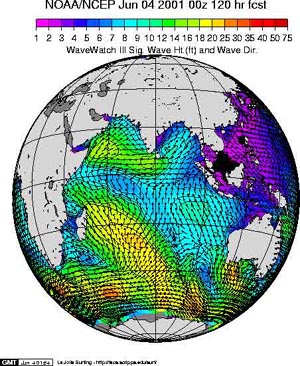 |
Further infos :
www.geographical.co.uk/expeditions_travel/expeditions/pakistan_expedition.html
www.surfmagic.co.uk/news/article.asp?SP=&v=&UAN=782
www.sandskater.co.uk/travel/pakistan.html
- / + TOUR / CAMP / YACHT
There are many ways of surftravelling. Backpaking with surfboards using public transport is a tough game because getting the best surf conditions require maximum mobility and because boards are oversized luggage. Most zones require a car to be able to choose the right spot with accurate information. Because most people can't handle travelling on their own, which is risky and time consuming, there has been a tremendous surge of surfcamps and yacht charters throughout the world. The reality is easily accessible spots are getting crowded and the only way to get uncrowded perfect surf is to aim at these remote worldclass only accessible by boat or designated camps. Depending on your time / money and your tourism / surf expectations, choose your ideal trip.
| TOUR | CAMP | YACHT | |||
| - | + | - | + | - | + |
|
Road traffic, potholes & washed out roads |
Maximum freedom |
Lack of variety of waves |
Short access to designated spots |
Seasickness can be a nightmare |
Exclusive access to landlocked spots |
|
Getting lost, possible police stops |
Relative low costs | Relative high costs | Getting confident on the same wave | Costs are very high due to boat operating costs | No road traffic, potholes,accidents |
| Car crash, bandits & break-in risks |
Combine different wavezones trips |
Early bookings for famous camps | Crowd control on those guest-limited camps | Getting caught in a storm is a major stress | No worry for food and water supply |
| Running out of gas, flat tyres, breakdowns | Ability to sleep in car / bus / R.V | Lack of discovery of sightseeings | No hassles with long transfers |
Hiring a shoddy boat is life threatening |
Straight view on the surf and zodiac access |
|
Car rental, gas, and toll expenses |
Fly & drive option : more luggage capacity |
Boredom possible when surf sucks |
No worry for food and water supply | Boat breakdowns can ruin your trip | No mosquitoes, insects and no malaria risks |
|
Road access restrictions |
Road trip experience |
Subject to land based problems | Idyllic times for short period stay | Without a / c, sleeping is very uncomfortable | Ability to go to different swell / wind spots |
|
Unsuitable to lone tripper |
Ability to surf off-the-beaten paths spots | No opportunity to meet local people | Early access and multiple daily sessions | You can get bored so bad if surf is flat | Waterman unique experience |
| Hotel bookings and itinerary decisions | Opportunity to visit sightseeings |
No shopping options for girlfriend |
Village atmosphere suitable for groups | Space is limited for walking and change air |
fishing and diving obvious options |
| Age requirement for rental cars | Guide : avoid getting lost, optimize spot choice | Remote access for some camps | Various types of beach activities | Crew or guest arguing can be very stressful | Cooler temps thanks to seabreeze |
| Exposure to deseases and low hygiene |
Guided option with surf instructor |
In case of emergency, hospital care is away |
Surf school or airport pick up options |
In case of emergency, hospital care is away |
Reef cuts have less risks of infection |
TOP12 SURFLINKS : SEARCH THE BEST WEBSITE AROUND THE GLOBE
Do we really need to bookmark websites as good ones have hundreds of links around especially with dedicated search engines ? As a result of constant browsing with cable connections, here is our list our favorite dozen.
WETSAND
(Ventura,Calif.) :
www.wetsand.com
KILLER SURF LINKS (Colorado Springs) :
www.killersurflinks.com
BOARDFOLIO (Carlsbad,Calif.) :
www.boardfolio.com
WIPEOUT (Australia) :
www.aaa.com.au/search/wipeout
8FTPERFECT (France) :
www.8ftperfect.com
COLDSWELL (England) : www.coldswell.com
PLANETSURF (Coral Gables, Fl.) :
www.planetsurf.net
THE SURF CONNECTION (Sweden) :
www.theglide.com/links/pages
CADE SURF (Brazil)
: http://www.cade.com.br/espsurf.htm
SURF4 (Canada) :
www.surf4.com
SURFER RESOURCES (San Diego, Calif) :
www.sdsc.edu/surf/surfer_resources.html
SURFLINK (Devon, England) :
www.asurflink.com
TOP100SURF (Australia) :
www.top100.com.au/global/sport/watersports/index.html
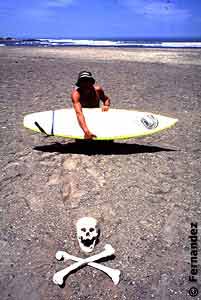 Nightmare in paradise
Nightmare in paradise
St Agnes surfer Greg Hendy suffered a horrific accident at G-Land in August when a surf board hit him in the neck, leaving him temporarily paralysed.
Greg and his mate Richard Atkinson had flown into Bali to meet his brother Luke Hendy and Adam Dakin for a long-awaited trip to Grajagan.
On the third day of perfect surf the boys were charging 6-8 foot barrels when disaster struck. After pig dogging through a barrel Greg got caught in the inside bowl at the end of the Speedies section. Surfacing after the initial wipeout he looked up to see a surfer trying to scratch into the bowl right above him. It was instantly apparent that the surfer was not going to make the wave, but he tried to take off anyway.
Greg's only option was to dive as deep as possible. But as he dove he saw the other surfer get pitched, go over his head and land behind him in the flats. Unfortunately in the mad scramble to get out of the way Greg didn¹t duck dive deep enough and was sucked back over the falls with the other surfer. Sometime during the wipeout Greg felt a sharp impact on the back of his head. It felt like a board had hit him. From then it turned into a nightmare. Everything went white and, although he was still thinking clearly, when he went to push up off the bottom his body wouldn't respond.
At the time he couldn't figure out what was happening, but he was paralysed. Still calm, Greg did the only thing he could, held his breath and hoped the buoyancy from the air in his lungs would carry him to the surface. Fortunately he got just high enough to break his mouth free and take a gasp of air before the next wave hit and smashed him again. It was only when the third wave hit and dragged one of his useless arms past his own face that Greg realised he was in really serious trouble. All he could think about was that this was how Mark Foo had died, and he didn¹t want to go the same way. On surfacing the third time he managed to scream for help. Luke, who had been surfing 200 yards up the reef, was the first to his aid and with the help of other surfers managed to get him onto his board, out of the water and carry him across the reef.
The group arrived at the camp where they got help from two medics who happened to be staying at the camp next door, but this was not he end of the nightmare. The crew quickly discovered that there was no established emergency procedure in the camp and its owner had gone off fishing, taking with him the only key to the sat phone (the only link to the outside world). In addition the first aid kit consisted of some dirty old bandages, a few plasters and a rusty pair of scissors.
The medics stabilised Greg the best they could by cutting up an old bodyboard to form a neck brace, and gaffa-taping Greg¹s head, neck, and torso to his surfboard to prevent movement. They then placed him on a table outside the warung, where he stayed from 4.30 that afternoon to 8am the next morning.
When the camp's owner eventually arrived and found the key to the sat phone it became apparent that he had no idea of any emergency service phone numbers or even where the camp was located. So after the pilots were eventually contacted, they had to go out to Denpasar and buy a Javanese road map. From this they navigated their way to Grajagan village, following the road to the nature reserve until they spotted the clearing the lads had hacked out of the jungle.
After a 45 minute transfer to Bali, Greg was told he needed an MIR scan and that the island didn't have the facilities. He was flown out that evening, some 26 hours after the initial accident, and arrived in a Sydney hospital still wearing the same boardshorts he had been surfing in, complete with a block of wax still in his back pocket.
The Aussie doctors told Greg, who still had no feeling in his upper body, that his neck hadn't been broken, but that a spinal disc had been dislodged and was putting pressure on his spinal cord. Five days later they operated to remove the disc and fuse together two vertebrae. Greg is now recovering in Sydney, but it will probably be a year until he gets to surf again.
Greg is one of the best surfers in the St Agnes area. His smooth powerful attack, watermanship and ability in big waves made him a standout wherever he surfed. He has placed highly in the British and English national contests, was Head Lifeguard at Porthtowan for four years and has travelled extensively. As such this story raises several questions especially with the growing numbers of surfers now enjoying the sport.
Firstly there's the repercussions of surfers new to the sport putting themselves into positions they may not be experienced in. Secondly there's the question of who polices the international surf camps and makes sure they have in place adequate emergency equipment and procedures. Fortunately Greg is a highly skilled and experienced surfer, and so is his brother and his friends who were on the trip. If they hadn¹t been capable of acting in an emergency situation Greg would probably be dead, or at the very least paralysed for life. These are not pleasant thoughts, but it all happened on a sunny offshore day when everyone was having the time of their lives. The question is if something similar happened tomorrow at your beach to you or your friends, would you know what to do?
Safety in surf camps
As the number of professionally run surf camps increase around the globe the time has come for a body to assess basic safety standards and equipment they provide their customers. It will be a challenging task, but one that has to be addressed.
Why?
Through printed media, video, marketing and contests sponsorship the surfing industry has actively encouraged and utilised the image of the travelling surfer. (Think of the Quiksilver Pro at G-Land, Gotcha in Tahiti, O¹Neill in Nias, Billabong at Mundaka.)
Our markets are growing, and more surfers are travelling as they do so more are inevitably going to get into some sort of trouble.
By endorsing and publicising a standard of global practice that would be respected and accepted by both the travel industry and our own core customers we can and will save lives.
| How? Just a basic knowledge will save lives in the future. Even a waterproof step by step procedure chart nailed to the wall of a jungle hut cold provide enough information to help an injured surfer immeasurably. Prospective contest sponsors could also encourage or pressure surf camp owners that host such events to adhere to basic safety standards. The safety code can be publicised on all marketing materials associated with travel accessories. The surf industry has the financial resources to fund an investigation into the provision of basic equipment and a guideline code, and probably to sponsor the production of surf camp medical packs. This could be on the basis of free issue, non for profit sale, or just an initial cash injection recoupable on the sale of a basic package with a small profit margin. |
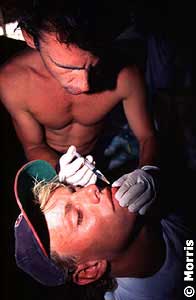 |
What is required?
A basic standard of practice that all surf camps are expected to adhere to.
A recommended surf tour/surf camp operator logo that can be recognised by potential travellers as a guarantee of basic emergency standards.
Medical guidelines to be held in each camp. A simple wall chart could potentially save a life. Information held should include:
emergency first aid ie CPR, immobilisation, dealing with shock;
camp grid references and an established emergency procedure for evacuation of customers however far away these services are
contacts of local emergency services
Equipment
Basic first aid kit, updated as required including a neck brace/spinal support board.
Some means contacting emergency services (ie sat phone, mobile phone, pager etc)
Press and advertising back up to inform the surfing world of the scheme
| | NEWS | | ARCHIVES | | ECO-LOGICAL | |
TOP
10 Surftravel agents
|
NAME
WEB |
AGENCIES / COUNTRIES | TEL | FAX |
|
The Surftravel Company |
nulla Beach, Australia STC - New Zealand World Wave - USA College Turismo - Brazil Travel
Scene - Japan Marina - France
|
1
800 SURF
73 (0)2 9527
4722 (0)9
473 8388
(0)760
438 WAVE (0)11
822 9839 (0)466
33 7083 (0)5 5841 8666
|
(0)2
9527 4522 (0)9
473 8388
(0)760
438 9283 (0)11
822 7806 (0)466
33 6535 (0)5 5841 8389
|
|
Waterways
Travel |
Van Nuys, California (USA) |
1 800 928 3757 818 376 0341 |
|
|
Wavehunters |
Santa Barbara, California (USA)
Worldsurfaris - Australia |
1 888
899 TUBE 805
899 2885 See below |
805 899 0048
|
|
Worldsurfaris
|
Wilston, Queensland (Aus) California (Wavehunters) |
1
800 611
163 (0)7
3861 1163 See above |
(0)7
3861 1165
|
|
Atoll
Travel |
Foster, Victoria Waterways - California Shanahan - New Zealand True Blue South Africa Maldives
Scuba Tours - England Turquoise
- France Surf
Travel - Brazil Albatros
- Italy
|
1
800 622 310 (0)3 5682
1088 See above (0)9
486 3091 See below (0)1449
780 220 (0)4
9113 9492 (0)21
422 0425 (0)544
363 34 |
(0)3
5682 1202 (0)9
489 7660 (0)1449
780 221 (0)4
9190 6011 (0)21
322 0756 (0)544
212 355 |
|
Global
Surf Travel |
Wailuku, Maui
(USA)
Queensland (AUS) |
808
244 1677 (0)7 552 00 962 |
808 244 3226 |
|
True Blue surf Travel |
Cape Town, South Africa
|
21 419 0618 |
21
419 0638
|
|
Nias
Tour |
Sao Paolo, Brazil | (0)11 256 1590 | |
|
Surf Express |
Satellite Beach, Florida |
321
779 2124
|
321 779 0652 |
|
Go Tours |
Southport, Queensland (AUS) | (0)7 559 12 199 | (0)7 553 21 854 |
TOP
10 Surftravel agents
| | NEWS | | ARCHIVES | | ECO-LOGICAL | |
Columbia
by Edgardo Arjona
earjona@etiendas.com
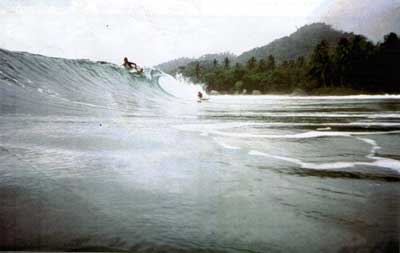
(c) Edgardo Arjona
|
The Pacific Side is a big mistery for the most of surf population in the caribean line, `cause the limitations it the roads, expensive cost life, and politicals-violence problems, keep out to all of us far away from there. But
we heard reports from Pacific ocean surfers talkin` about 10-15 feet, perfect brakes, and big bombs (18-23ft)... and too many unexplored beaches. On the Atlantic side, we can drive most of the time, and discover a lot of
perfect beaches with a good size waves. We got a good season but we have waves all the year, finding waves from 2 to 8 feet from face. The bigger surf
population lives in Barranquilla (like me) and Cartagena, where people starts to take this seriously, but the grommets don't have any type of sponsor and all of this shit. We are building a web site from our club "IGUANA-MAR" Surf Club. |
|
|
|
Spots : Arrecifes (Tayrona Park), El bolsillo (Barranquilla), Locals : Ivan Borrero, Edgardo Arjona, Leonardo Parias, Jaime Martinez, Alberto Barrios, Mario Cobo Web : www.iguanamar.com |
| | NEWS | | ARCHIVES | | ECO-LOGICAL | |
Sam George : edito Surfer Mag June 2000
|
The April2000 issue of Surfer featured a letter written by a property owner of The Hollister Ranch, taking exception to Dave Parmenter's January "Coyote
Lines", which disparaged the proprietary culture that has always defined that fabled
surfzone. "An owner" and his letter sparked considerable response from
readers, virtually all siding with Parmenter and the "have-nots", calling bullshit on what they perceived as an attitude of selfish exclusivity only thinly disguised as "soul". This is a topic-and a conflict- I have given a lot of thought. And not just because while along with chastising DP, " An Owner" also takes a few shots at me while he's at it : "Sam George and other media types repeatedly come visit the owner they befriend", the "owner" writes, "then go on to destroy the place in the press". |
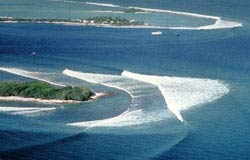 |
This isn't the place to address the fact that I've been surfing there for more than 25 years and have yet to befriend a single
owner. But the second part of the accusation does bear examination. Has the surf media destroyed the Ranch through exposure ? By my
reckoning, the last major mag feature appeared in 1976. Previous to that, there were several environmental articles urging surfers to save Cojo Point from a LNG port. And in 1972, a beautiful Jeff Divine photo essay included a sales pitch penned by the Ranch manager on behalf of the property's new developers (I don't count the latest Surfer's Journal
feature, written by George Greenough, who is above our petty concerns and can write whatever and wherever he
chooses.)
But over the past 30 years, that's about it. Seen in this light, it's obvious that in contrast to
"destroying" the Ranch's pristine quality, the surf mags have actually played a major hand in protecting it. Bottom line, the mags don't run photos or stories about the Ranch. Why ? Because a handful of older editors-myself
included- grew up surfing there and would continue to do so without it being totally
overrun. Simple as that.
Then, perhaps it's appropriate that these letters in Dave's defense appear in this issue, while contemporaneously featuring two travel stories focusing on previously unseen surf locations. In both cases, the surf photographers involved submitted their work insisting that
while, of course, we run spread after spread of their colorful work, under no circumstances are we to say where the photos were
taken.
My first response was that this was pure hypocrisy. Why in the world would anyone who's in the slightest way concerned with preserving a surf spot's secret nature shoot photos and then submit them to SURFER
mag, the sport's most pervasive forum ? If it's supposed to be secret, then why tell us ? And if
we, a magazine dedicated to our readers and their intimate relationship with the sport, can't provide at least a context in which to package this latest
fantasy, why should we run the photos at all ?
Yeah, that was my first response. "It's spozed to be a secret, then keep your big mouth shut and your lens cap on. If not, then face the
consequences."
But, then, I started thinking about the Ranch and wondering who the hypocrites really
were. You've got Ranch owners who've mortgaged their sould in the name of
exclusivity, legitimate surf explorers who can't seem to resist telling everybody about their
discoveries, surf photographers who (with the exception of the truly intrepid John
Callahan) simply go on "assignment" to expose these spots while at the same time asking the mags not to tell anyone else how to enjoy the same privilege they have afforded by the big surfwear companies that in end the end pay all our bills. And there's me
who, as a member of the dreaded "surf media", is supposed to package it all and still sleep at night.
It's a real mess and nothing as a surfer can fix. But as editor of SURFER
mag, here's my call : " We"ll continue not acknowledging the existence of perfect surf " North of
Gaviota" not in deference to any smug property owners with their $75,000 parking permit, but instead to honor the memory of the late John Bradbury, the big-hearted Ranch Pioneer who named most of the
friggin' spots yet still found in his soul to share. As far as SURFER's main-staple travel stories are
concerned, we'll draw no maps, but we will at least place the feature on the globe, prviding a
legitimate, sincere impetus for further exploration and adventure.
Hey, it doesn't make sense, I know. But neither do waves not everyone can surf, secrets nobody can
keep, nor the sad fact that we haven't outgrown any of this crap yet.
| | NEWS | | ARCHIVES | | ECO-LOGICAL | |
WEST AFRICA
| INTRO : Stuart Butler is an hardcore British bodyboarder who took a courageous 2-month surftrip from Morocco to Guinea-Bissau. Using public transportation, he crossed the Saharan Desert skirting the coast, witnessing the huge potential of virtually unexplored shores of South Morocco, Mauritania, Gambia and Bijagos islands in Guinea Bissau. Although he experienced many technical problems with his camera, he did a few original
shots. The world may now be fully explored and mapped, but for surfers huge swathes of the planet are as blank and unknown as it was for the medieval map makers. Several trips to northern Morocco had left me intrigued, south of Anchor Point and the world once again became an unknown blank. I'd obviously heard of the waves around Dakar in Senegal, but that left thousands of kilometres in between and beyond. The first European explorers to Africa had come in search of wealth, they found it in the form of gold and slaves, I was searching for gold of a different type. |
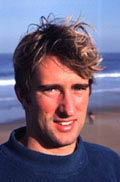 (c) Yep |
This is not the story of my trip through west Africa, more the results of what I found. Although I am usually loath to reveal the location of secret surf spots, I feel that the normal rules do not really apply to the majority of places I went to on this trip. They were all either well known surf areas like the Dakar and Anchor Point regions, for which there is obviously no point in hiding the location, or they are places so remote and difficult of access with no local or travelling surfers and never really likely to be, that to reveal their locations is unlikely to cause problems. Also anyone else who is planning a trip down this coast really deserves all the help they can get. I have, though, kept the identity of one spot hidden, as it is vulnerable to increasing crowds and the present mellow scene there could be destroyed.
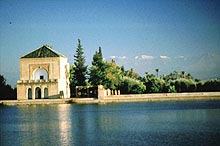
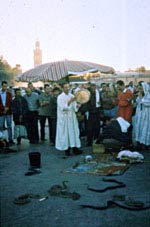
(c) Butler
My journey begins in Rabat, Morocco's capital, and a well known part of the surf world. On my way south I discovered that the French influenced and very cosmopolitan cities of Rabat and Casablanca contain a wealth of good beach breaks, and in Rabat a decent river mouth wave that only breaks on big swells. All these waves are ridden by a large and welcoming surf population.
Between Casablanca and the Anchor Point region are dozens of beaches and points with minimal crowds and plenty of scope for new discoveries. It is Anchor Point, though, that is for many travelling surfers the start and end of the Moroccan surf scene. This is something I find a little odd, the points here pick up far less swell than the rest of the country, which means that unless the northern beaches are maxed, you could face long flat spells down here. The quality of the waves here doesn't, I feel, equal that of the rest of the country, offering few chances to get fully barrelled, although it is only fair to point out that I am a bodyboarder and maybe look for a slightly different wave to many stand ups. The scene here is generally laid back, but beware of the touts and thieves who seem more active here than anywhere else in the country.
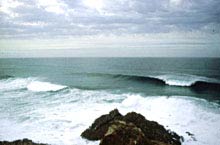 (c) Butler |
Whilst at Anchor Point a monster swell hit, as this died off I continued south and entered explorer territory, I had no idea of what I was going to encounter, the map was now blank. The first hundred kilometres or so immediately to the south of Agadir is quite staggering, literally every half a kilometre is another reef, point or beach. One small town in particular had an excellent right hand reef, that quite frankly made the waves around Anchor's pale into insignificance. |
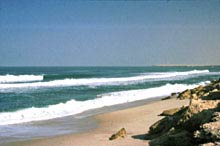
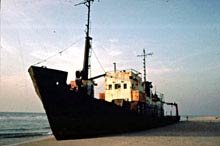
(c) Butler
The first glimpse of the desert appeared just to the south of this town, the overloaded share taxi I was travelling in climbed to the summit of some small scrubby hills, to the south of which stretched endless kilometres of sand and gravel plains, I was to see no more greenery for the many weeks it was to take crossing this alien and strangely inspiring world. The road took an inland detour before rejoining the coast at the busy, colourful town of Tan-Tan, the waves here broke into a small, beautiful bay as a reasonable left hander, slightly fat on the outside section, but turning into a fast hollow shorebreak. Access to the ocean became far harder after Tan-Tan, distances between towns and villages unimaginably vast and high cliffs meaning that many of the thousands of reefs and beaches would remain forever unridden. Many times the reefs would be the wrong shape and the waves closing out, but every now and then a truly classic wave would be revealed and conveniently these were frequently where ancient river beds and gullies carved through the cliffs and into the reefs, producing deep water channels and reef passes and easy access from the road to the beach. Surfing along this coastline is an incredibly spooky experience, few waves have been ridden down here, medical help is hours away, the sealife tends to be on the giant side, massive swells can arrive in the space of hours and as a final scary extra are the many large shipwrecks lining the beaches, everything from small inshore trawlers to ocean going tankers, washed up by some of the most ferocious swells on earth.
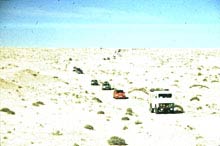 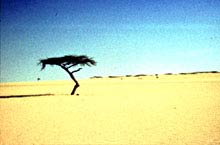 (c) Butler |
The long disputed border of Morocco and the Western Sahara was fast approaching, since the Spanish pulled out of this country in 1975 it has been embroiled in a vicious war between the Moroccans and Mauratanians, who both claim a historical right to the territory and the Polisario guerrillas, representing the native Sahrawis, who with Algeria's backing are fighting to reclaim the land for themselves. In the last few years a very fragile UN brokered cease fire has been in place and Morocco has effectively taken control of the country. Although a much postponed vote between the Moroccans and the Sahrawis over who will gain official control of the country is due very soon, the possibilities for travel in this region may come to a grinding halt. An ex Polisario guerrilla that I later met in Mauritania, told me that if the vote is cancelled by the Moroccans again or if the vote does not go the Sahrawis way then they will once again take up arms. All this should be borne in mind by anyone wanting to travel in this region and also be warned that the going gets decidedly harder after crossing the border into the Western Sahara. Distances between towns become ever greater, yet you appear to make little impression on a map of the Sahara, the heat, even in mid-winter is draining, do not even consider coming here in the summer! The ocean becomes even less accessible, with the road often running way inland and suspicious military checkpoints are everywhere, leaving you under no false pretensions that you are travelling in a war zone. The scenery down here also becomes extremely monotonous, hundreds of kilometres can pass by with not a single sign of life or the slightest change in landscape from a dead flat gravel plain. I was frequently left wondering what on earth it was that so many people had been willing to die for down here! It is possible to reach the surf in all three major coastal towns and in one or two other places. The best spots when I was there were a right point in the village of Skyamat, to the north of Dakhla and several very good reefs and points on the narrow Dakhla peninsula, which is the southern most town in the Western Sahara that it is possible for tourists to visit without permits and military escorts. |
I, though, had been lucky enough to obtain a visa for Mauritania and the necessary Moroccan permits to continue south of Dakhla the three hundred and fifty kilometres to the Mauritanian border. It was the first stage of the route to the Mauritanian capital of Nouakchott, and was a journey not to be under taken lightly, infact this one thousand kilometre route is widely regarded as one of the toughest desert crossings on the planet.
The first town I'd reach in Mauritania is the country's second city, Nouadhibou, to get here involves joining a military escorted convoy, without your own transport this can be a problem as there is no public transport to the border and you have to rely on the kindness of people with their own vehicles, my ride was on an overland truck that takes groups of tourists across Africa.
The first day of the journey is along a relatively good tarmac road and the going is easy, day two and the tarmac peters out to be replaced by soft sand and numerous check points. Infact we only had to cover thirty kilometres on this second day, but it took sixteen hours due to constantly digging cars out of sand drifts and dealing with self important border guards after bribes. The coast along this stretch revealed some of the best set ups for surf I have ever seen, the swell was small, but located in one bay were two right points and a "slab" style reef, both points were very long and extremely hollow whilst the "slab" was a short, but near square barrel. Further south still stood a whole heap of beaches and reefs. Unfortunately I didn't surf any of them and neither will you, the reason being that this is a highly sensitive border zone and scattered amongst the sand dunes are thousands of land mines, laid by all sides in the war. The twisted remains of vehicles line the road to Nouadhibou, proving that these mines are no idle threat, and killing off any thought of a quick jaunt over the sands for a surf.
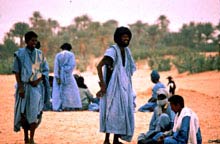
(c) Butler
The opening description of Mauritania in my guide book reads, "Much of Mauritania forms part of the Sahara desert - a region of shifting sand dunes, rugged mountain plateaus and rocky outcrops. Life in this harsh land is affected by overwhelming poverty, lack of resources and ethnic conflicts. Few travellers visit and one could almost suggest that it is the one country to avoid. To some this place is the pits - sand and an overwhelming sense of revulsion." This promising description did little to encourage enthusiasm in me, and was made worse when I discovered that despite being outlawed in 1981, slavery still continues on a relatively large scale in the country's remote interior.
The guide book description of Mauritania turned out to paint a slightly over the top picture of the country, but there is no doubt that Mauritania is a no bullshit kind of country, you have to want to be there and appreciate that things are going to be just a little different to what you may be used to in Europe! Aside from island nations, Nouadhibou has to be the only major city in the world with no real road connections to anywhere else, infact there are only three surfaced roads in the entire country.
| Like Dakhla, Nouadhibou is located at the end of a pencil thin peninsula, the western side of which has several small bays along its length, one contains the village of La Gouira with a good right point and a beach break, unfortunately to reach this village involves considerable risk. The border between Western Sahara and Mauritania runs the length of this peninsula, there is no road to the village, so you have to trek across the desert for three hours to get there. Aside from the obvious and very high risk of being caught by the authorities, you have the added excitement of knowing that this is one of the heaviest mined areas of the country - I wouldn't recommend it! Don't despair though, at the very tip of the peninsula is a fantastic wave and it doesn't involve illegal border crossings, only another trek along a lightly marked track, again with a few land mines. The wave is a two part set up, stage one is an insane right hand shore break wedge which works its way along the beach, before wrapping around the east side of the peninsula and turning into a hollow right point break, and in the winter at least the northerly desert winds will always blow offshore. The swell was small when I was there, and I think that when a big swell hits the wedge section may not work, but the point is probably really sick. The cold water here is one of the richest fishing grounds in the world and the water is teeming with massive fish and a colony of extremely rare Monk seals (possibly the last one on earth), because of the seals this area is a national park, and you need permits to enter. Don't do what I did, and enter without them, after twenty minutes in the water, police and park officials turned up and tried to arrest me, I only escaped by running for two hours over the desert ! | 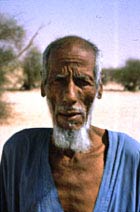 (c) Butler |
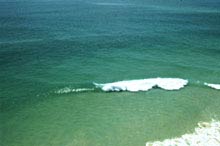 If you look at a map of Mauritania, then you will see that the area directly south of Nouadhibou contains an intriguing mix of headlands and islands, you will also notice that no road or track leads down this coast line, a knowledgeable guide is absolutely essential, to attempt this route without one would be suicidal. It is a journey through a landscape stripped to the basics of sand, sky and rock and though largely barren and lifeless it can be an intensely moving and spiritual experience. It turned out that the maps were deceiving and that the ocean here is extremely shallow for fifty odd kilometres out to sea, preventing any swell getting
in.
If you look at a map of Mauritania, then you will see that the area directly south of Nouadhibou contains an intriguing mix of headlands and islands, you will also notice that no road or track leads down this coast line, a knowledgeable guide is absolutely essential, to attempt this route without one would be suicidal. It is a journey through a landscape stripped to the basics of sand, sky and rock and though largely barren and lifeless it can be an intensely moving and spiritual experience. It turned out that the maps were deceiving and that the ocean here is extremely shallow for fifty odd kilometres out to sea, preventing any swell getting
in.
Halfway between Nouadhibou and Nouakchott and the coastline changes to a beachbreak, with the occasional reef that stretches all the way to Dakar in Senegal, the water becomes relatively deep again and swells can once again get in, producing typical beach break waves. The most obvious place in which to base yourself for surfing along this beach being Nouakchott, where I left the overland truck, and St-Louis, a decaying colonial town in northern Senegal, that marks the end of the Sahara desert, the vegetation gradually becoming more and more lush until you enter a typically tropical landscape in southern Senegal.
At the end of the Cap Vert peninsula, the most westerly point in Africa, stands the capital of Senegal, Dakar, a large modern African city where business can be accomplished with a minimum of fuss, but the crime rate is very high. Escape the city as soon as possible and head for the Almadies point area of the peninsula, here are a couple of beach breaks, half a dozen reefs of very good quality and the first surf shop and board repairer since Casablanca. The line ups here are relatively empty with a few local surfers and a higher number of French expatriates and tourists. Depending on the season you will surf either the north or south side of the Peninsula, and be guaranteed offshore conditions all day, the south side offered the best reefs, but needs a bigger swell to break. N'gor village is the best place to stay offering a chilled out, easy holiday, although it is not the most attractive of areas and some people may not like the very French atmosphere, it does helps if you speak a bit of French.
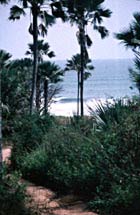 (c) Butler |
South of Dakar surf becomes a much more hit and miss affair, most of the coastline faces away from the swell direction, only breaking very occasionally, one bonus though is that the water temperature rises dramatically meaning that it is possible to surf in boardshorts. Gambia is a bizarre British colonial creation, following no particular tribal lines and entirely surrounded by Senegal, for English speakers though it offers a wonderful rest from the pidgin French conversations and tough travel of the last four thousand kilometres. More importantly though, and unknown to almost everyone, it also offers waves, it only has a small swell window which is at its best around the resort town of Kololi. The waves are beach peaks and can be quite good, I heard a rumour of some reefs around Tanji, but I couldn't be bothered to go and check them out! The weird thing was that I had a reasonable sized swell here, whilst the more exposed Dakar peninsula remained flat. |
Since leaving Mauritania things had, I felt, been getting too easy, it was time to liven stuff up a bit. South of Senegal and Gambia is the almost totally unknown ex Portuguese colony of Guinea-Bissau. In 1998 a coup had left the country involved in a very nasty civil war, thousands of refugees had attempted to leave the country, most had failed, as a functioning country it had ground to a halt, and the capital Bissau had become an extremely dangerous place. In May 1999 the military Junta had entered Bissau city, disarmed its opponents, many of whom were child soldiers as young as ten, and taken control of the country. Amazingly the Junta set about preparing for democratic elections, which took place five days before I entered the country, the land borders reopening the day before. Needless to say the only foreigners I was to meet here were a few journalists in Bissau and refugees from Sierra Leone and Liberia.
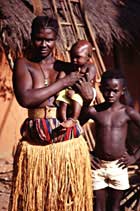
(c) Butler
It was fairly obvious that there was no surf on the mainland, due to the coastline being sheltered from north Atlantic swells by the bulge of Senegal, offshore though is a chain of islands called the Bijagos archipelago, of which I thought the most north westerly island, called Caravela, may get surf on big swells. Transport to and from Caravela is extremely hard to find, involving lots of hopping between islands in fishing canoes. Once there I discovered a tribal community that had no contact with the rest of the world, it was unlike anything I've ever experienced in several years of travel in the remoter areas of Africa and Asia. Money is an unknown concept, people trade for things by barter, to enter any village, I had first to gain permission from the village headman, most freaky of all was that the women wore only grass skirts! Known locally as Ethiopia, due to a lack of food, my diet was limited to one plate of plain rice a day and whatever I could find in the bush. Aside from the experience of visiting such a community, it was a fairly unsuccessful journey as I didn't find any surf on this island, the water here was very shallow and there was only a small swell hitting the west African coastline. On one nearby island, the water was deeper and small beach break waves were breaking, though weak I think a bigger swell would produce reasonable waves. The best part of visiting was that the islands insect population thoughtfully gave me a souvenir that on my return to England left me in Torbay hospital over the Christmas and New Year period.
Guinea-Bissau was as far as I was heading, south of here and the surf comes from the south Atlantic and the European summer is the best season, although I'd been plagued by small swell for most of the trip, I saw some places with definite potential for world class waves on big swells, but it is going to take many, many years until this coastline is fully explored. If you decide to go and look, take a knowledge of French, a ton of patience, someone to surf with and most usefully your own transport. The gold past explorers were searching for could be found in the big, empty perfection, hidden in the blank section of the map.
TRAVEL FACTS ON WEST AFRICA
Getting around West Africa requires initiative, a huge helping of patience and plenty of time, it also helps if you're not fussy about where you stay or what you eat. Whatever you encounter along the way you are guaranteed the surf adventure of a lifetime.
The first step on your journey is to reach Africa, for this you have a variety of options depending on the type of trip you want, many people will only want to explore a small part of west Africa and for these people the best option may be a flight to their preferred destination. Morocco, Senegal and Gambia have far more flight connections with Europe and will be considerably cheaper to fly to than Western Sahara, Mauritania and Guinea-Bissau. At the moment the cost of standard, year return flights to Morocco, (Casablanca) are £830 with Royal Air Maroc (A direct flight)
Senegal, £495 with Sabena
Gambia, £682 with Sabena
These are quoted by Trailfinders, the same flights or flights with other airlines will of course be available for a fraction of this price with Trailfinders and many other travel companies. It is possible to get flights to Morocco and Gambia for less than £200, if your flexible.
For those wanting to do a full overland trip from Morocco southward then numerous ferries carrying cars and foot passengers do the short crossing from southern Spain to Tangier in Morocco.
Public transport around west Africa is generally pretty good, with plenty of buses that go to most major towns, Morocco also has an excellent train service. There are exceptions to this rule though, the stretch from Dakhla in the Western Sahara to the Mauritanian border has no public transport and you will have to hitch this part. Transport can also be a bit hit and miss in Mauritania and Guinea-Bissau. Except for northern Morocco, the "roads" are some of the worst in the world and all journeys will take hours, sometimes days, longer than you expected.
It is quite possible to take your own vehicle and sell it in west Africa for a reasonable profit at the end of your trip, many French people do this every winter. Organising this is a fairly complicated business that involves some proper research before you leave.
Accommodation can range from five star hotels in the cities to a village hut in the rural regions, aside from Morocco, it can be suprisingly expensive and frequently of extremely low standards (Bottom range accommodation in Bissau city is more expensive than London and the standards are the lowest I have found in any African city). Food is cheap everywhere, but don't expect a wide variety.
Most people will be suprised to find that west Africa is anything but a cheap destination, Morocco is far and away the cheapest country in the region. Everywhere else transport, accommodation, western food and anything imported is going to be at least the same price as in Britain.
Visas are not needed by most EU nationals in Morocco, Senegal and Gambia. Visas for Guinea-Bissau are easy to obtain and everyone needs one, Mauritania can be a problem as officially they do not issue visas for overland entry and you often need to have an air ticket in and out of the country before they will even consider your application. At present it seems that Paris is the best place in which to get one.
You must remember that things change very fast in Africa, but with a bit of common sense you should have a trouble free trip, the police can cause problems for you in Mauritania and occasionally in Guinea-Bissau, other problems you may encounter are petty theft or more serious muggings, language difficulties and if you're very unlucky, war! Both Lonely Planet and Rough Guides publish guide books to Morocco and west Africa, although they tend to be a bit thin on the ground, when it comes to providing information on the areas surfers are likely to be interested in.
| | NEWS | | ARCHIVES | | ECO-LOGICAL | |
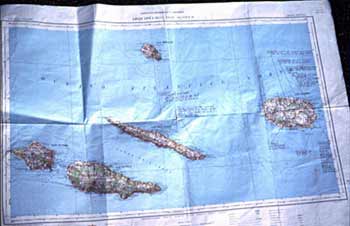
SURFING GUIDES : the death of secret spots ?
For a long time, surfing guides have been banned by the hardcore surf community. The rule of thumb was that any travelling surfer should shut up about spot names they would discover. Not telling anybody about a great surf experience is beyong most human beings. However, some surfers managed to remain under this pledge of secrecy. (Jeff Clark surfed by himself Mavericks for 15 years). Telling a friend was then not considered a crime unlike publishing spot indications in surfmags because this info could end up in two many ears for the surfspot to withstand public exposure.
That was the time of the great discoveries he 60's and 70's (Bali, G-Land, Nias, Baja, Puerto Escondido, Taghazout, Costa Rica, Fiji) by the pioneers of surftripping (Peter Troy, Craig Peterson, Kevin Naughton, Randy Rarick...). Stories ran in Surfer Magazine would give only vague clues about locations. This editorial guideline remains until now and has been followed by most surfmags in the world. In the mean time, Surfer Mag started a low-key surf travel publications aimed at providing a worldwide spot data to the travelling community. Since 1981, THE SURF REPORT has edited over 200 monthly issues over the world, reaching an estimated coverage of 80% of the surf shores with a full description of spot access, wave features and travel specifications.
Even though the surfmags publishing policy hasn't changed over the last 20 years, the worlwide surf community has been booming because surfing is a fabulous sport enhanced by an ever growing culture of sports and travel combined with a society focused on freedom. While the ISA's figure of 18 million surfers might seem overrated, there is no denying that travelling surfers have reached millions. Such figure requires some kind of management. According to GBI's Rick Cameron, there would be 2 million new active surfers every year. A growing part of surf travellers are relying now on surf operators : camps & schools, tours & boats, operators and agents...The global surfing zone is extending towards boat access breaks, secluded camps in dangerous areas, high latitude cold water destinations...But the option still remains for many surf regions to travel on your own. Therefore, wanderers need a relevant tool to manage their trip. If they only rely on well-known spots published by surfmags or contest sites, that means most surfers would gather to a very limited number of the major spots who would be overcrowded. Not telling about spots favors that ugly territorial behavior known as Localism. Some locals think they own the spot because they surf there all the time, assuming nobody will ever break their privilege. Funnily enough, the same guys who blame surfing guides telling about their own private garden, have been the happy users of Surf Report publications when they travel abroad. We heard the very same surfers despise surfmags articles and confess they got hooked by surfing looking at a picture in a mag. Basically, the local's theory is : I've started surfing or I surfed that spot before you, it's okay for me and my friends to surf there but you are a kook or too late, just leave. It's high time to discourage that selfish behavior.
The idea of a surfmap, according to Yep ethics, is to increase the spot's public knowledge, let's say to a 90%. But not 100%. If you take a zone of 10 potential spots, there has to be 1 spot off the map, formerly referred as " the secret spot ". Real secret spots in most wavezones don't exist any more, some waveriders know this place but it's been kept low key for several reasons : tricky access, unconsistent break, land or wave dangers...The map provides a graphic info base for the waverider to search the coastline and get curious about both underwater and land topography. The global guideline is to enhance the waverider towards knowledge of the wave, the place and the people. Safety is a big issue and waveriders have to be aware of the local dangers. Thus, flows of waveriders are better orientated depending on their skills, their wave tools and their ability to take risks. Spot types favor a better distribution of waveriders so anyone finds his Mecca. Example : worldclass, pointbreak, rivermouth, cliff reefbreak, swell magnet, big wave reef, mushy beachbreak, secret, longboard heaven, beginner's beach, bodyboard'shorebreak, jetty break, experts only, sucking hardbreaking ledge, kid's playground...
The surftrip Atlas is only a pre-guide, not a practical guide. It's not designed to be used as a travel guide on-site but as a decision tool to find about where, when and why to go on a surftrip. Then, you need to get a practical guide as well as a surfing guide. We recommend Lonely Planet for their in-depth information, cultural aspects as well as their commitments in surfing sections for some countries.
We do that job because first, we love surfing and travelling.Thus, we want to be able to stay as close to the waves as possible getting a decent income from that growing trend. We believe publishing informations about spots is not a crime. Of course, it has its downside on the surf environment like every human activity involved in production but it can also mean a better surfing future. It's called positive evolution. Be convinced we will use part of our energy to protect what we live for and do our best to educate surfers, who are not always careful of their trips' local impact. What will become an absolute priority in the near future
(cf.eco-logical), unlike other sketchy characters that could develop the same business with less eco-concerns and more interests towards money, power and glory.
Wherever you go tripping, just keep images, leave only footprints.
(c) The Wave Slaves
P.S
: We will
publish monthly travel topics in this section regarding specific equipment, health, surf forecasting , transport, travel operators...Stay in touch
subscribing to our free mailing list.
| | NEWS | | ARCHIVES | | ECO-LOGICAL | |